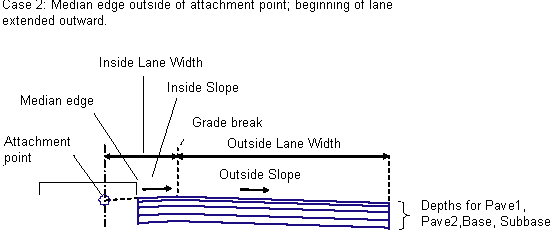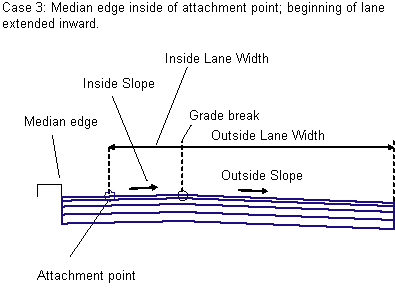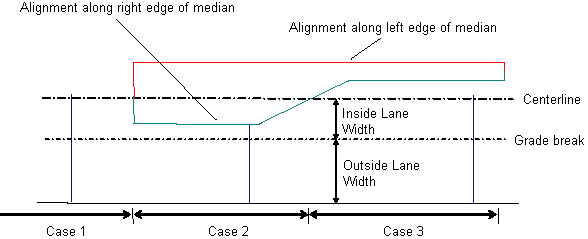This subassembly inserts one or more travel lanes outward from an alignment that defines the edge of a median.
The alignment defining the edge of the median may at times be either not present (Case 1), outside the roadway centerline (Case 2), or inside the centerline (Case 3).
To use this subassembly, you should have separate alignments defining the left and right edges of the median. It may be necessary to define separate corridor model regions for each individual median. This subassembly differs from LaneFromTaperedMedian1 in that it provides for a grade break with different slopes in the travel lanes.




Attachment
The attachment point is at the location where the inside edge-of-traveled-way would be if there was no median. This is typically at the assembly baseline.
Input Parameters
Note: All dimensions are in meters or feet unless otherwise noted. All slopes are in run-over-rise form (for example, 4 : 1) unless indicated as a percent slope with a “%” sign.
|
Parameter |
Description |
Type |
Default |
|---|---|---|---|
|
Side |
Indicates the outward direction of the lane |
Left / Right |
Right |
|
Inside Lane Width |
Width of the inside lane for the condition where there is no median; that is, from the attachment point to the grade break point. |
Numeric |
3.6 m 12.0 ft |
|
Inside Lane - Use Superelevation Slope |
Specifies to use the superelevation slope for the inside lane. Choices are No, Outside Lane Slope, and Inside Lane Slope. |
String |
Inside Lane Slope |
|
Default Inside Slope |
Specifies default slope for the inside lane. This value is used if superelevation slope is not used, or is not specified for the baseline alignment. |
Numeric, positive |
2.0% |
|
Outside Lane - Use Superelevation Slope |
Specifies to use the superelevation slope for the outside lane. Choices are No, Outside Lane Slope, and Inside Lane Slope. |
String |
Outside Lane Slope |
|
Default Outside Slope |
Specifies default slope for the outside lane, if superelevation slope is not specified. |
Numeric, positive |
- 2.0% |
|
Outside Lane Width |
Width from the grade break point to the outside edge-of-traveled-way. |
Numeric |
3.6 m 12.0 ft |
|
Inside Adjustment |
Used if the Median Edge alignment is at a fixed offset from the actual edge-of-traveled-way (for example, at the back of curb). Adjusts the calculated Inside Lane Width to account for the offset (see diagram). |
Numeric, positive |
0.0 |
|
Outside Adjustment |
Used if the Outside Lane Width alignment is at a fixed offset from the actual edge-of-traveled-way (for example, at the back of curb). Adjusts the calculated Outside Lane Width to account for the offset (see diagram). |
Numeric, positive |
0.0 |
|
Pave1 Depth |
Depth between finish grade and Pave1 (zero to omit) |
Numeric, non-negative |
0.025 m 0.083 ft |
|
Pave2 Depth |
Depth between Pave1 and Pave2 (zero to omit) |
Numeric, non-negative |
0.025 m 0.083 ft |
|
Base Depth |
Depth between Pave1 and Base (zero to omit) |
Numeric, non-negative |
0.100 m 0.333 ft |
|
Subbase Depth |
Depth of the Subbase layer at the attachment point (zero to omit) |
Numeric, non-negative |
0.300 m 1.0 ft |
Note that if the Inside %Slope value is always the same as Outside %Slope, or if Inside Lane Width is zero, then the simpler LaneFromTaperedMedian1 subassembly can be used instead.
Target Parameters
This section lists the parameters in this subassembly that can be mapped to one or more target objects. For more information, see To Specify Corridor Targets.
|
Parameter |
Description |
Status |
|---|---|---|
|
Median Edge |
May be used to shift the starting offset of the lane to follow an edge-of-median alignment. The following object types can be used as targets for specifying this: alignments, polylines, feature lines, or survey figures. |
Optional |
|
Inside Lane Width |
May be used to override the fixed Inside Lane Width and tie the grade break to an offset alignment. The following object types can be used as targets for specifying the width: alignments, polylines, feature lines, or survey figures. |
Optional |
|
Outside Lane Width |
May be used to override the fixed Outside Lane Width and tie the edge-of-lane to an offset alignment. The following object types can be used as targets for specifying the width: alignments, polylines, feature lines, or survey figures. |
Optional |
|
Outside Elevation |
May be used to override the normal lane slope and tie the outer edge of the travel lane to the elevation of a profile. The following object types can be used as targets for specifying the elevation: profiles, 3D polylines, feature lines, or survey figures. |
Optional |
Output Parameters
|
Parameter |
Description |
Type |
|---|---|---|
|
Superelevation Axis of Rotation |
Indicates whether the subassembly supports the axis of rotation calculation. To view a description of the parameter, in the Properties window, hover the cursor over the parameter. For more information, see Profile Grade Line Adjustments During Superelevation. |
Static (Description) |
|
Inside Lane Width |
Width of the inside lane |
Numeric |
|
Inside Lane %Slope |
% slope of the inside lane |
Numeric |
|
Outside Lane Width |
Width of the outside lane |
Numeric |
|
Outside Lane %Slope |
% slope of the outside lane |
Numeric |
Behavior
Grade Break: The width from the attachment point outwards to the grade break between the inside and outside lanes can be defined by a fixed numeric width, or an alignment can be used to override the width. The elevation at the grade break is determined by applying the specified slope for the inside lane across the width of the lane.
Outside Edge-of-Traveled-Way: The width to the outside edge-of-traveled-way can be defined by a fixed numeric width, or an alignment can be used to override the width. The elevation is determined by applying the specified slope for the width of the lane, unless an Outside Elevation profile is given. In that case, the outside edge elevation is tied to the profile, and the slope is adjusted.
Inside Edge-of-Traveled-Way: The location of the inside edge-of-traveled-way is calculated based on the three cases shown in the previous diagram. If a Median Edge alignment is given, and that alignment is outside of the lane’s attachment point, the inside edge is shifted outward from the attachment point at the lane slope (Case 2). If the Median Edge alignment is inside of the lane’s attachment point, the inside edge is shifted inward from the attachment point at the inside lane slope (Case 3). If no Median Edge alignment is given, or the given one is not found at a station, the inside edge is held at the attachment point (Case 1).
Inside and Outside Adjustments: The Inside Adjustment and Outside Adjustment parameters are provided in case the alignments used for the inside or outside edges are at a fixed offset from the actual edge-of-traveled-way. For example, the alignment being used for the Median Edge may be at the back-of-curb instead of at the pavement edge. In this case, the Inside Adjustment parameter should be set to the width of the curb.

Layout Mode Operation
In layout mode, this subassembly displays the links comprising the lanes for the given widths and slopes. If a superelevation slope is given (LI or LO), the links are displayed at a slope of -2%.
Point, Link, and Shape Codes
The following table lists the point, link, and shape codes for this subassembly that have codes assigned to them. Point, link, or shape codes for this subassembly that do not have codes assigned are not included in this table.
|
Point, Link, or Shape |
Code |
Description |
|---|---|---|
|
P1, P3 |
ETW |
Edges of lane on finish grade |
|
P4, P6 |
ETW_Pave1 |
Edges of lane on Pave1 layer |
|
P7, P9 |
ETW_Pave2 |
Edges of lane on Pave2 layer |
|
P10, P12 |
ETW_Base |
Edges of lane on Base layer |
|
P13, P15 |
ETW _Sub |
Edges of lane on Subbase layer |
|
P2 |
Crown |
Crown (grade break) on finish grade |
|
P5 |
Crown_Pave1 |
Crown (grade break) on Pave1 |
|
P8 |
Crown_Pave2 |
Crown (grade break) on Pave2 |
|
P11 |
Crown_Base |
Crown (grade break) on Base |
|
P14 |
Crown_Subbase |
Crown (grade break) on Subbase |
|
L1, L2 |
Top, Pave |
Finish grade surface |
|
L3, L4 |
Pave1 |
Pave1 surface |
|
L5, L6 |
Pave2 |
Pave2 surface |
|
L7, L8 |
Base |
Base surface |
|
L9, L10 |
SubBase, Datum |
Subbase surface |
|
S1 |
Pave1 |
Area between finish grade and Pave1 |
|
S2 |
Pave2 |
Area between Pave1 and Pave2 |
|
S3 |
Base |
Area between Pave2 and Base |
|
S4 |
SubBase |
Area between Base and Subbase |
Coding Diagram
